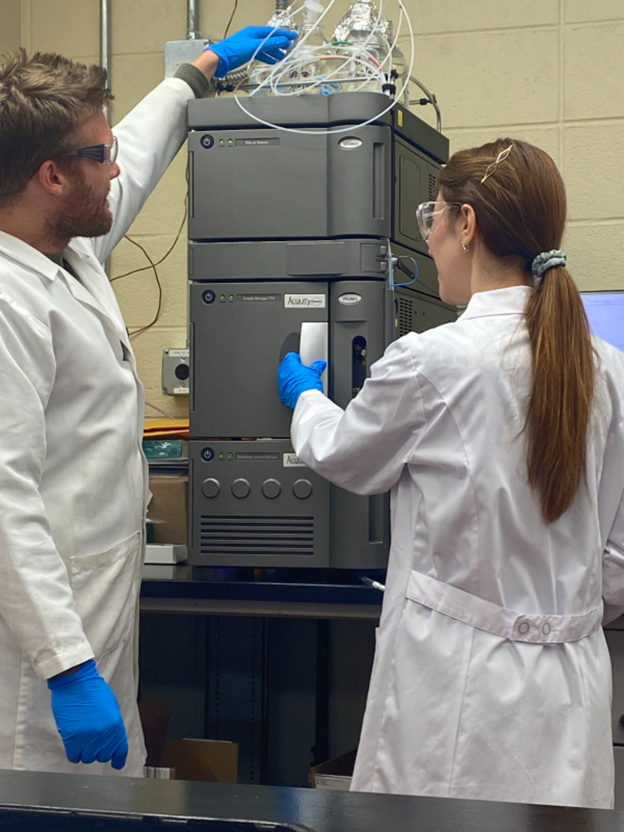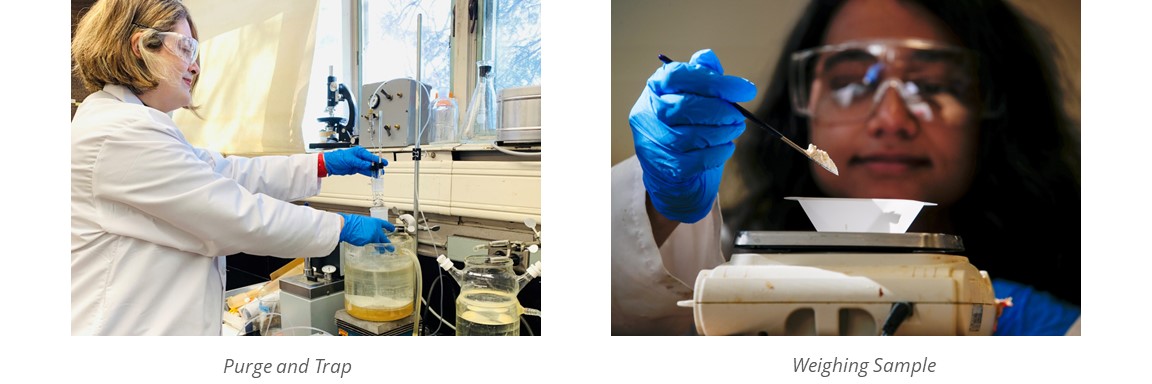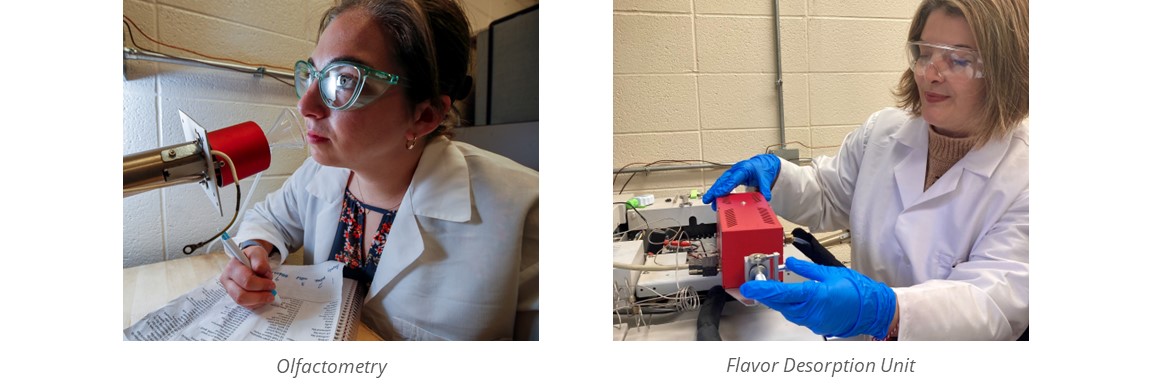Nutritional and Flavor Analysis
Nutritional Analysis
| Analysis |
Purpose |
Protein Digestibility via Megazyme K-PDCAAS
|
Protein digestibility is conducted to determine in-vitro digestibility measurement of the Animal-Safe Accurate Protein Quality Score.
To determine Protein Digestibility Corrected Amino Acid Score (PDCAAS) value.
|
Ultra Performance Liquid Chromatography (UPLC; Waters Acquity Premier) with Photodiode detector
|
This system is currently being used for determining the amino acids composition in plant protein samples. |
Flavor Extraction Techniques
| Analysis |
Purpose |
Solvent Assisted Flavor Extraction (SAFE)
|
SAFE is considered one of the best overall methods for "clean" aroma extraction and is capable of extracting compounds from complex matrices. Volatile aroma compounds are isolated from an organic solvent extract under high pressure resulting in high recovery of aroma compounds from non-volatile compounds. |
Static Headspace via Agilent 7694 Headspace Sampler
|
The static headspace technique involves the extraction of volatile and semi-volatile compounds in the vapor/headspace above a food sample in a vial that is equilibrated at the desired temperature. An aliquot of the vapor/headspace can be analyzed by gas chromatography to determine the concentration of the compounds of interest. |
Solid Phase Micro Extraction (SPME)
|
SPME is a solvent-free sample prep technology. SPME uses a fiber coated with a polymer sorbent for extracting the compounds from the sample by adsorption. It is then injected directly into the GC-MS for desorption and analysis. |
Stir Bar Sorptive Extraction (SBSE)
|
Following the SBSE technique, a magnetic stir bar with a polymer coating is placed inside the sample vial. The extraction is a function of an equilibrium between the coating and the analytes in solution. This method is used for a quick evaluation of flavor compounds without much sample preparation. |
Two Units of Purge and Trap/ Dynamic Headspace coupled with Gerstel Thermodesorption System (TDS) and Cooled Injection System (CIS)
|
Purge and trap is a dynamic headspace extraction method. Samples are purged with inert gas causing volatile and semi-volatile compounds from the sample to enter the vapor/headspace and become adsorbed onto a trap containing adsorption material. After extraction of flavor compounds using Stir Bar Sorptive Extraction or Purge and Trap, compounds are thermally desorbed using the Gerstel TDS and are then cryofixed and injected into a gas chromatograph using a Gerstel CIS. The Gerstel TDS and CIS allow for highly sensitive and accurate determination of volatile and semi-volatile flavor compounds. |
Analytical Measurement of Flavor Compounds
| Analysis |
Purpose |
Gas Chromatography (ALS ready G1530 A)-Olfactometry- Inert Mass Selective Detector (Agilent Technologies 5975)
|
GC is a common type of chromatography used in separating compounds that can be vaporized (gas). Volatile flavor compounds are carried by a carrier gas and separated through a polymer coated column. Analytes can then be analyzed using various types of detectors (FID and MS). Olfactometry allows for detection of odor active compounds. Analytes separated by GC can be split for detection (i.e., MS) and evaluation by sniffing at a sniff port to identify the compounds that are odor active and their odor intensity. Mass spectrometry is used for ion separation by their mass-to-charge ratio and to detect them qualitatively and quantitatively by their respective m/z and abundance. |
GC (Hewlett Packard 5890 Series II) with FID
|
FID is the most commonly used detector used to detect ionized compounds formed during combustion via hydrogen flame. The generated ions are proportional to the concentration of the compound. |
GC (Agilent Technologies 6890N) with Inert Mass Selective Detector (5975)
|
Gas Chromatography Mass Spectrometry (GC-MS) is a technique that combines the separation capacity of gas chromatography with the sensitivity and selective capacity of the mass spectrometer. This combination allows analyzing and quantifying trace compounds in complex mixtures with a high degree of effectiveness. |
Gas Chromatography (Agilent Technologies 7890 A) with TOFMS (PEGASUS 4D)
|
The sample analytes are ionized, and the ions are accelerated using an electrical field. They travel through the flight tube before they collide with the detector at the end of the tube. The velocity of individual ions depends on their so-called mass-charge ratio (m/z) where ions with smaller m/z travel faster and hence hit the detector earlier. The flight time of each ion is recorded and used to create a mass spectrum. |
Ultra Performance Liquid Chromatography (UPLC; Waters Quatro Premier XE) with Triple Quadrupole mass spectrometer
|
UPLC-MS/MS is used for separating non-volatile compounds using liquid chromatography followed by highly sensitive and selective tandem MS subsequently identifying them. |
Liquid Chromatograph (Shimadzu LC-10AD) with single quadrupole mass spectrometer (Waters Micromass ZQ)
|
LC-MS is a liquid chromatography technique used for physical separation of analytes or target compounds in a sample followed by identification and analysis using mass spectrometry. |


